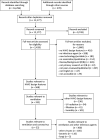The impact of heating, ventilation, and air conditioning design features on the transmission of viruses, including the 2019 novel coronavirus: A systematic review of ventilation and coronavirus
- PMID: 36962357
- PMCID: PMC10021902
- DOI: 10.1371/journal.pgph.0000552
The impact of heating, ventilation, and air conditioning design features on the transmission of viruses, including the 2019 novel coronavirus: A systematic review of ventilation and coronavirus
Abstract
Aerosol transmission has been a pathway for the spread of many viruses. Similarly, emerging evidence has determined aerosol transmission for Severe Acute Respiratory Syndrome coronavirus 2 (SARS-CoV-2) and the resulting COVID-19 pandemic to be significant. As such, data regarding the effect of Heating, Ventilation, and Air Conditioning (HVAC) features to control and mitigate virus transmission is essential. A systematic review was conducted to identify and comprehensively synthesize research examining the effectiveness of ventilation for mitigating transmission of coronaviruses. A comprehensive search was conducted in Ovid MEDLINE, Compendex, Web of Science Core to January 2021. Study selection, data extraction, and risk of bias assessments were performed by two authors. Evidence tables were developed and results were described narratively. Results from 32 relevant studies showed that: increased ventilation rate was associated with decreased transmission, transmission probability/risk, infection probability/risk, droplet persistence, virus concentration, and increased virus removal and virus particle removal efficiency; increased ventilation rate decreased risk at longer exposure times; some ventilation was better than no ventilation; airflow patterns affected transmission; ventilation feature (e.g., supply/exhaust, fans) placement influenced particle distribution. Few studies provided specific quantitative ventilation parameters suggesting a significant gap in current research. Adapting HVAC ventilation systems to mitigate virus transmission is not a one-solution-fits-all approach. Changing ventilation rate or using mixing ventilation is not always the only way to mitigate and control viruses. Practitioners need to consider occupancy, ventilation feature (supply/exhaust and fans) placement, and exposure time in conjunction with both ventilation rates and airflow patterns. Some recommendations based on quantitative data were made for specific scenarios (e.g., using air change rate of 9 h-1 for a hospital ward). Other recommendations included using or increasing ventilation, introducing fresh air, using maximum supply rates, avoiding poorly ventilated spaces, assessing fan placement and potentially increasing ventilation locations, and employing ventilation testing and air balancing checks. Trial registration: PROSPERO 2020 CRD42020193968.
Copyright: © 2022 Thornton et al. This is an open access article distributed under the terms of the Creative Commons Attribution License, which permits unrestricted use, distribution, and reproduction in any medium, provided the original author and source are credited.
Conflict of interest statement
This work is funded by The Canadian Institutes of Health Research and Alberta Innovates. There are no patents, products in development or marketed products to declare. This does not alter our adherence to PLOS policies on sharing data and materials. The authors have declared that no other competing interests exist.
Figures
Similar articles
-
The impact of heating, ventilation, and air conditioning design features on the transmission of viruses, including the 2019 novel coronavirus: A systematic review of ultraviolet radiation.PLoS One. 2022 Apr 8;17(4):e0266487. doi: 10.1371/journal.pone.0266487. eCollection 2022. PLoS One. 2022. PMID: 35395010 Free PMC article.
-
The impact of heating, ventilation, and air conditioning design features on the transmission of viruses, including the 2019 novel coronavirus: A systematic review of filtration.PLOS Glob Public Health. 2023 Sep 19;3(9):e0002389. doi: 10.1371/journal.pgph.0002389. eCollection 2023. PLOS Glob Public Health. 2023. PMID: 37725631 Free PMC article.
-
The Impact of Heating, Ventilation, and Air-Conditioning Design Features on the Transmission of Viruses, Including SARS-CoV-2: Overview of Reviews.Interact J Med Res. 2022 Dec 23;11(2):e37232. doi: 10.2196/37232. Interact J Med Res. 2022. PMID: 36343208 Free PMC article. Review.
-
The impact of heating, ventilation and air conditioning (HVAC) design features on the transmission of viruses, including the 2019 novel coronavirus (COVID-19): A systematic review of humidity.PLoS One. 2022 Oct 10;17(10):e0275654. doi: 10.1371/journal.pone.0275654. eCollection 2022. PLoS One. 2022. PMID: 36215321 Free PMC article.
-
Reducing Virus Transmission from Heating, Ventilation, and Air Conditioning Systems of Urban Subways.Toxics. 2022 Dec 17;10(12):796. doi: 10.3390/toxics10120796. Toxics. 2022. PMID: 36548629 Free PMC article.
Cited by
-
Built Environment and SARS-CoV-2 Transmission in Long-Term Care Facilities: Cross-Sectional Survey and Data Linkage.J Am Med Dir Assoc. 2024 Feb;25(2):304-313.e11. doi: 10.1016/j.jamda.2023.10.027. Epub 2023 Dec 5. J Am Med Dir Assoc. 2024. PMID: 38065220 Free PMC article.
-
Ambient carbon dioxide concentration correlates with SARS-CoV-2 aerostability and infection risk.Nat Commun. 2024 Apr 25;15(1):3487. doi: 10.1038/s41467-024-47777-5. Nat Commun. 2024. PMID: 38664424 Free PMC article.
-
COVID-19 workplace countermeasures that occupational physicians could not change in Japan: a qualitative study.BMC Public Health. 2025 Jan 8;25(1):93. doi: 10.1186/s12889-024-21219-9. BMC Public Health. 2025. PMID: 39780108 Free PMC article.
-
Reducing Transmission of Airborne Respiratory Pathogens: A New Beginning as the COVID-19 Emergency Ends.Environ Health Perspect. 2024 May;132(5):55001. doi: 10.1289/EHP13878. Epub 2024 May 10. Environ Health Perspect. 2024. PMID: 38728219 Free PMC article. Review.
-
Immunomics in one health: understanding the human, animal, and environmental aspects of COVID-19.Front Immunol. 2024 Sep 4;15:1450380. doi: 10.3389/fimmu.2024.1450380. eCollection 2024. Front Immunol. 2024. PMID: 39295871 Free PMC article. Review.
References
-
- ASHRAE. ASHRAE epidemic task force releases updated airborne transmission guidance. 5 April 2021. American Society of Heating, Refrigerating, and Air-Conditioning Engineers (ASHRAE). https://www.ashrae.org/about/news/2021/ashrae-epidemic-task-force-releas.... Accessed April 22, 2021.
-
- World Health Organization (WHO). WHO Director-General’s opening remarks at the media briefing on COVID-19–11 March 2020. https://www.who.int/director-general/speeches/detail/who-director-genera.... Accessed April 4. 2021.
-
- World Health Organization (WHO). Naming the coronavirus disease (COVID-19) and the virus that causes it. https://www.who.int/emergencies/diseases/novel-coronavirus-2019/technica.... Accessed April 15, 2021.
LinkOut - more resources
Full Text Sources
Research Materials
Miscellaneous

